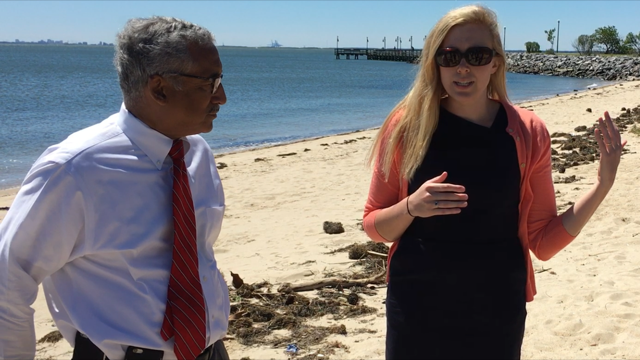Proposed Legislation Seeks to Stimulate Investment in Coastal Resiliency
May 16, 2017
 U.S. Rep. Robert C. "Bobby" Scott discusses his proposed legislation, the BUILD Resilience Act, with Emily Steinhilber of the ODU Office of Research.
U.S. Rep. Robert C. "Bobby" Scott discusses his proposed legislation, the BUILD Resilience Act, with Emily Steinhilber of the ODU Office of Research.
By Jon Cawley
Waves gently lapped onto a Newport News beach May 15 as U.S. Rep. Robert C. "Bobby" Scott stood with Emily Steinhilber of Old Dominion University's Office of Research and members of the Wetlands Watch environmental group to informally introduce legislation intended to help communities improve coastal resilience.
The calm, late-spring day was the perfect setting, Scott said, to highlight the need to proactively pursue infrastructure improvements that would minimize impacts from storms and recurrent flooding.
Scott's plan, the Building Up Infrastructure to Limit Disasters through Resiliency Act - also referred to as the BUILD Resilience Act - would authorize $1 billion a year to establish a program similar to the National Disaster Resilience Competition (NDRC), a competitive grant program facilitated by the U.S. Department of Housing and Urban Development (HUD).
Last year, Virginia was awarded $120.5 million through the NDRC to address recurrent flooding in Norfolk's Chesterfield Heights neighborhood as a result of a competitive grant effort spearheaded by Old Dominion.
Scott chose the Salters Creek watershed, in southeast Newport News, as the location to discuss his proposed legislation because a proposed sea wall project there, along with several others in Hampton Roads, were not approved through the HUD competition because of limited federal funding.
The bill would also create a National Research Center for Resilience to work with HUD to establish a network to share best practices and provide assistance to communities interested in investing in resilience measures.
Steinhilber said the proposed legislation would promote cooperation across communities, which is essential to proactively address sea level rise encroachment because "watersheds do not stop at political boundaries."
She stressed the importance of using a "multijurisdictional approach. It's just so important for solutions that actually make the most sense and that use our limited resources the best way possible, as opposed to just knocking projects out," Steinhilber said.
Scott said the BUILD Resilience Act is modeled after HUD's 2013 initiative, following Hurricane Sandy, that reallocated $1 billion from the Disaster Relief Appropriations Act to begin investing in resilient strategies through the NDRC program.
"With these projects, you can save a lot of money," he said. "The estimate, if we don't do anything, is that there is about $5 trillion in damages we can expect. But if we take the preventative approach, we can save about 80 percent of those damages - that's what prevention and the bill does."
Scott said he chose HUD as the funding apparatus of his bill because it served as the mechanism for Virginia's successful $120.5 million grant application, in which Old Dominion University played a key coordinating role.
"We have the experience," the Democrat said. "We didn't want to reinvent the wheel."
The Virginia NDRC application was led by Old Dominion, which for decades has been a hub of climate change and sea level rise research. It was one of 13 projects to receive funding in a competitive bid process that saw 40 entries from 26 states and Puerto Rico.
The grant application involved staff from Old Dominion's Office of Research and Virginia Modeling, Analysis and Simulation Center (VMASC), as well as the cities of Chesapeake, Norfolk and Newport News, all of whom gathered input from local stakeholders. In all, more than 100 workshops, work groups, committee meetings and forums were held to seek input.
The end product, thRIVe, aligns with HUD's national objective to directly benefit low- and moderate-income residents and households by focusing on unmet recovery needs, as well as building regional resilience capacity to adapt to sea level rise and manage extreme weather events.
ThRIVe has five major goals: unite the region; create coastal resilience; build water management solutions; improve economic vitality, and strengthen vulnerable neighborhoods. This comprehensive approach is designed to capitalize on the region's strengths, convert risk and vulnerabilities into economic opportunities, and demonstrate best practices to low-lying areas nationwide.

